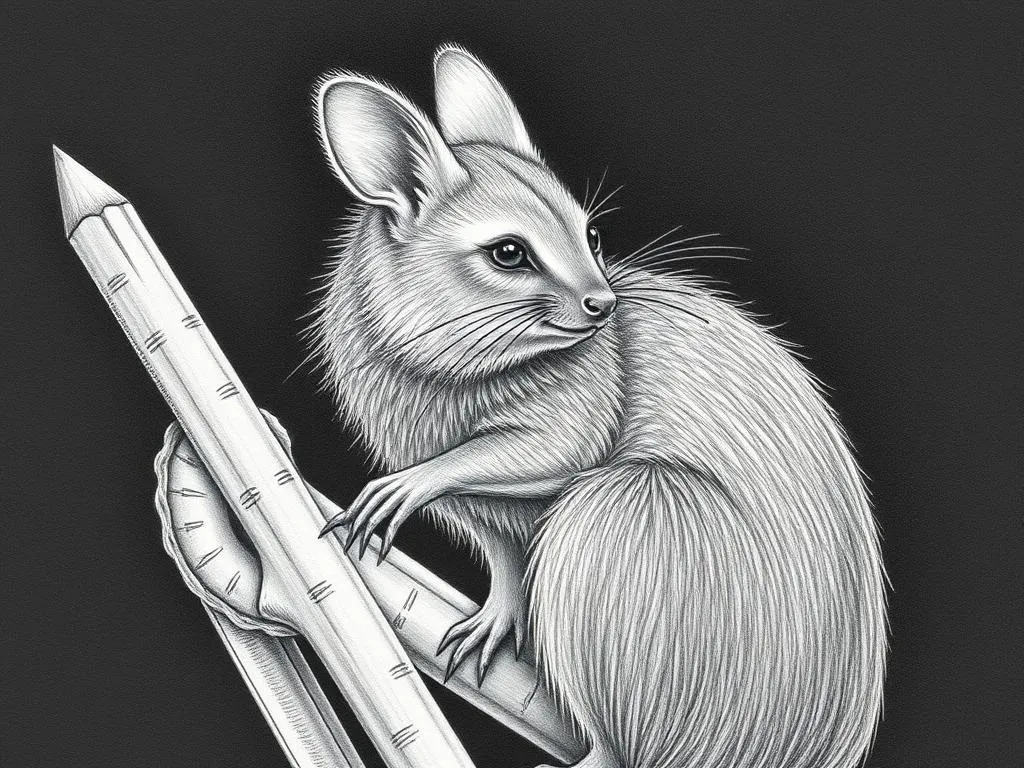Pademelon: The Symbolism of a Unique Marsupial

Disclaimer: Some images on this website are AI-generated artworks and may not accurately represent real animals.
Understanding the Pademelon
Description and Habitat
The pademelon is a fascinating marsupial native to Australia and New Guinea. Belonging to the family Macropodidae, which also includes kangaroos and wallabies, pademelons are smaller and distinctly different from their larger relatives. There are several species of pademelons, with the most well-known being the red-necked pademelon and the brown pademelon.
Pademelons typically inhabit dense forests and bushland, often favoring areas with thick undergrowth that provide them with shelter and food. These marsupials are primarily nocturnal, which means they are most active during the night. They are adept at navigating through their lush surroundings, using their keen senses of hearing and smell to detect predators.
In terms of physical characteristics, pademelons are compact, with a stocky build, short limbs, and a long, muscular tail that helps them maintain balance. Their fur is generally coarse and can range in color from reddish-brown to grayish, depending on the species.
| Physical Characteristics | Description |
|---|---|
| Size | 70-100 cm in length |
| Weight | 5-15 kg |
| Fur Color | Reddish-brown, gray, or dark brown |
| Tail Length | Approximately equal to body length |
| Lifespan | 8-12 years in the wild |
Role in the Ecosystem
Pademelons play a crucial role in their ecosystems. As herbivores, they contribute to the balance of plant life by grazing on grasses, leaves, and fruits. This feeding behavior helps maintain healthy vegetation and promotes biodiversity within their habitats. Moreover, they serve as prey for a variety of predators, including foxes, birds of prey, and large reptiles, thereby sustaining the food chain.
Interactions with other species further illustrate the pademelon’s ecological importance. They help disperse seeds through their droppings, which can lead to the growth of new plants. This process fosters a thriving ecosystem by encouraging plant diversity and providing food sources for other wildlife.

Symbolism & Spiritual Meaning
Connection to the Earth
The pademelon symbolizes a deep connection to the Earth, representing groundedness and stability. This symbolism is closely tied to their natural habitat, where they thrive in dense forests filled with vibrant life. Observing a pademelon in its environment can evoke feelings of safety and security, reminding us of the importance of being rooted in our surroundings.
Their relationship with nature also highlights the significance of preserving natural habitats. As we witness the challenges facing wildlife today, pademelons serve as a reminder of the delicate balance within ecosystems and the importance of protecting our planet.
Adaptability and Resilience
Another significant aspect of pademelon symbolism is adaptability and resilience. These marsupials have evolved to thrive in various environments, showcasing their ability to overcome challenges. For instance, their nocturnal behavior allows them to avoid daytime predators while still finding food and shelter.
The lessons we can learn from the pademelon’s lifestyle are invaluable. In our own lives, we often face obstacles that require us to adapt and find new solutions. The pademelon’s resilience encourages us to embrace change and navigate life’s challenges with grace.
Playfulness and Joy
Pademelons are known for their playful behavior, which adds a layer of joy to their symbolism. They often engage in playful activities, such as hopping around and chasing one another, which speaks to the significance of play in our lives.
This playful nature encourages us to find joy in our daily experiences and to not take life too seriously. Just as pademelons embrace fun and play, we can learn to incorporate more lightheartedness into our own lives, enhancing our emotional well-being and overall perspective.
Pademelon in Dreams
Dream Interpretation
Dreams involving pademelons can carry profound meanings and insights. Common themes associated with dreaming about these marsupials often revolve around adaptability, playfulness, and a connection to nature. For instance, dreaming of a pademelon may suggest that you are navigating a period of change in your life, encouraging you to embrace new experiences with resilience.
When encountering a pademelon in a dream, it may also symbolize a need for grounding and connection to your surroundings. This dream could be a gentle reminder to pause and reflect on your relationship with nature and the environment around you.
Symbolic Messages
The symbolic messages derived from dreaming about pademelons can provide valuable guidance for personal growth and new beginnings.
| Common Dream Themes | Symbolic Messages |
|---|---|
| Encountering a pademelon | Embrace change and adapt to new situations |
| Pademelon in a playful context | Allow yourself to experience joy and lightheartedness |
| Observing pademelons in nature | Reconnect with your surroundings and find stability |
These insights encourage reflection on personal challenges and the importance of being open to new opportunities. By paying attention to the messages from pademelon dreams, individuals can gain clarity and direction on their life’s path.
Modern Interpretations
Cultural Significance
In Aboriginal mythology, pademelons hold cultural significance and are often featured in stories that emphasize their role in the ecosystem and the spiritual lessons they embody. These narratives highlight the connection between humans and nature, reminding us of the importance of coexistence and environmental stewardship.
Contemporary representations of pademelons in art and literature further emphasize their unique symbolism. They are often depicted as playful creatures embodying joy and resilience, serving as reminders of the beauty of nature and the lessons it imparts.
Conservation and Awareness
Modern efforts to protect pademelon habitats are crucial for their survival. Habitat destruction, climate change, and predation by invasive species pose significant threats to these marsupials. Conservation initiatives focus on preserving their natural habitats and raising awareness about the importance of biodiversity.
The symbolism of the pademelon is increasingly relevant in the context of environmental awareness. By recognizing the role these creatures play in their ecosystems, we can better understand the importance of protecting our natural world. Embracing the pademelon’s symbolism encourages us to take action in our own lives, fostering a sense of responsibility towards the environment.
Key Takeaways
- The pademelon represents groundedness and stability, reminding us of the importance of our connection to nature.
- Their adaptability and resilience serve as powerful symbols for overcoming life’s challenges.
- Playfulness and joy are integral to the pademelon’s nature, encouraging us to embrace lightheartedness in our daily lives.
- Dreaming about pademelons can provide valuable insights for personal growth and navigating change.
- The cultural significance of pademelons highlights the importance of coexistence and environmental stewardship.
Conclusion
In summary, the pademelon is more than just a unique marsupial; it embodies various layers of symbolism that resonate with our lives. From their deep connection to the Earth to their lessons in adaptability and joy, pademelons provide valuable insights into how we can navigate our own journeys.
Embracing the teachings of the pademelon encourages us to connect with nature, adapt to change, and find joy in our experiences. By reflecting on their symbolism, we can cultivate a deeper appreciation for the natural world and the lessons it imparts. As we move forward, let us not forget the wisdom of the pademelon and the significance of living in harmony with our environment.







